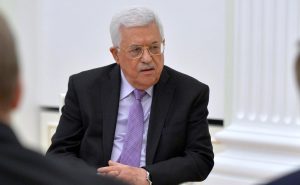
PA president Mahmoud Abbas. Image credit: Kremlin.ru, CC BY 4.0, via Wikimedia Commons.
The Palestinian Authority has been rocked by a series of protests in the past month in an outburst of frustration prompted by the death of anti-corruption activist Nizar Banat in PA custody last month.
What happened
- Banat’s death at the hands of Palestinian officials drew fresh attention to what critics describe as the increasingly autocratic rule of PA president Mahmoud Abbas, 85.
- Banat was seized in a wave of arrests last month, after which his family claim he was beaten to death by PA security officers.
- The PA has conducted an increasingly blatant clampdown on democratic processes, freedom of expression, judicial independence and nongovernmental organisations in recent years.
- Protests against the PA’s authoritarianism have spread from Ramallah across the West Bank, including to Bethlehem and Hebron.
Protests in Ramallah
Several hundred Palestinians gathered in Clock Tower Square in central Ramallah last week to protest against the PA’s brutality in the wake of Banat’s death. The peaceful protest turned violent when a group of allegedly plainclothes Palestinian security officials, connected with Abbas’s ruling Fatah party, appeared. The New York Times reported seeing pro-government forces charging at protestors, throw stones at them, beat them with clubs, flagpoles and fists, and snatch mobile phones from those attempting to document the events. Security forces also fired tear gas at the protestors. “They are not hiding it anymore”, yoga teacher Wissam Husseini, 29, told the New York Times. “This is a second occupation actually, not really a government”. Mr Husseini claimed to have been beaten and pepper-sprayed.
A Bad Time for Abbas
The protests have come at the worst possible time for the PA’s octogenarian president.
- Abbas, first elected in 2005, is now 16 years into his 4-year term.
- Abbas’s already dwindling popularity plummeted in April, when he cancelled what would have been the first Palestinian elections in over 15 years.
- The PA’s legitimacy took another blow in May, when its main rival, Hamas – the terrorist group that controls Gaza – launched rockets against Israel, casting itself as the defender of Jerusalem and the leader of the Palestinian people.
- The ensuing 11-day war was followed by a wave of arrests against dozens of critics of the PA in the West Bank.
- A June poll found that 84 percent of Palestinians believe the PA is tainted with corruption, as well as mismanagement and nepotism.
- Accusations of nepotism were given credence when Muatasem Muhaisen, a top Fatah official, was appointed to a senior health ministry position despite having been accused of assaulting a hospital director.
- March saw the PA come under further criticism for redirecting limited vaccine supplies towards the Fatah leadership, media allies and the families of dignitaries.
- Echoing the Arab Spring a decade ago, one recent protest saw demonstrators chant “the people want the fall of the regime” outside Abbas’s Ramallah headquarters.
Backed into a corner
Khalil Shikaki, director of the Palestinian Center for Policy and Survey Research, has drawn a direct link between Abbas’s position and the increasing authoritarianism. When Abbas feels threatened, Shikaki told the New York Times, his “tolerance for dissent becomes less and less”. He continued: “We are not yet Hafez al-Assad’s Syria or Saddam Hussein’s Iraq, but from the separation of powers to free speech to a pluralistic society, all of this has come under attack”. Shikaki’s polling company has reported that it had found it increasingly difficult to publish results in Palestinian news media, having had his bank accounts frozen upon refusing to comply with new regulations.
Uneasy foundations
The Palestinian Authority, created in 1994, was never intended to be a permanent government.
- The PA was intended to last up to five years, by which time Israel and the Palestinians were supposed to have agreed on a final peace accord.
- The PA exercises limited control over parts of the West Bank, in line with the 1993–5 Oslo Accords. Despite stalling peace talks, the PA has survived with the support of the United States and Europe.
- The PA court system has been severely weakened by Abbas, with decrees since 2019 enabling Abbas to wield more influence over the courts, including the firing of noncompliant judges.
- Ahmad al-Ashqar, who was forced to retire as a judge in January for opposing Abbas’s appointments, has claimed “the judges are afraid of having what happened to me happen to them”.
- The PA has also clamped down on nongovernment groups, including requiring them to submit plans for research, activities and estimated budgets.
- Freedom of speech is also under attack, with a 2018 electronic crimes law being used to block websites that could “threaten national security, public order or public morals”.
Israel’s shadow
Historically, Palestinians have been torn between protesting against the PA’s failures and focusing their anger against Israel. However, the death of Banat and the harsh suppression that has emerged in recent months has realigned opinions, with frustration being more focused at an increasingly authoritarian, ineffective and undemocratic Palestinian Authority than Israel itself. This Monday saw Al-Hayat Al-Jadida, the PA’s official newspaper, claim that demonstrations against Abbas worked “in favour of an agenda calling for sabotage and chaos” and “served Israel and its aggressive racist goals”.
Nizar Banat
Mr Banat, 42, was a house painter who began posting videos expressing his frustration with Abbas’s government.
- His videos, which often became angry broadsides, gained a substantial following.
- Banat had been a candidate on the Freedom and Dignity electoral list for the Palestinian legislative elections, which were cancelled by Abbas in April.
- Banat had been calling on the EU to end financial assistance to the PA, which he accused of “squandering European taxpayer money”.
- Family members said that Palestinian security officers burst into the Hebron home where Banat was staying on 24 June, beating him viciously and dragging him away.
- This was not the first attack on Banat: in early May, unidentified gunmen fired bullets, stun grenades and tear gas at his home.
- A Palestinian official initially said that Banat’s heath had “deteriorated” during his arrest, while justice minister Muhammad al-Shlaldeh announced last Wednesday that Banat had suffered an “unnatural” death.
- General Talal Dweikat, a spokesman for Palestinian security forces, said on Friday that 14 people had been referred to the military justice system and that investigations into Banat’s death would continue.
- The US, which has financed, trained and equipped the Palestinian security forces since the 1990s, said it was “deeply disturbed” by Banat’s death, while also expressing its “serious concerns about Palestinian Authority restrictions on the exercise of freedom of expression by Palestinians and harassment of civil society activists and organisations”.
Echoes of Khashoggi
The nature of Banat’s death, and the unexpected response from everyday Palestinians, has repeatedly been likened to the death in 2018 of Jamal Khashoggi, an outspoken Saudi journalist whose criticism of Saudi Arabia’s autocratic rulers prompted state anger. A state hit squad killed Mr Khashoggi in Istanbul in October 2018, before unsuccessfully attempting to cover it up.
More of the same
Allegations of arbitrary arrest and torture by the PA have been rife for years.
- A 2018 report from Human Rights Watch accused both the Palestinian Authority and Hamas of routinely using arbitrary arrest and torture as tools to crush dissent.
- Hamas supporter Haitham Amro died in PA custody in 2009, after which an autopsy determined that his cause of death had been torture. Five intelligence officers were charged by a then acquitted by a military court.
- In 2018, a West Bank journalist was detained by PA security forces for four days after he photographed the Palestinian prime minister’s convoy on his phone.
- Tom Porteous, deputy program director at Human Rights Watch, said in 2018 that “Palestinian authorities have gained only limited power in the West Bank and Gaza, but yet, where they have autonomy, they have developed parallel police states”.
- An earlier Human Rights Watch report from 1995 drew attention to the “perilous state of human rights in the Palestinian self-rule areas”.
Actions have consequences
Despite attention on the protests, few Palestinians expect any imminent changes.
- Journalist Shatha Hammad, 32, said “what they did over the last days has scared people and intimidated them”. Hammad was injured and had her phone smashed at one anti-Abbas protest.
- A young Palestinian builder who spent 10 days in jail in Jericho disputed official denials of a crackdown, saying he had been arrested over an oblique insult aimed at the PA that he had posted on Facebook.
- Speaking to the New York Times anonymously, he said he had been beaten up and humiliated during daily interrogations. Comparing his experience in Israeli detention, he said: “[The Israelis] have rules. There’s a law, a system. There’s no law in the Palestinian Authority”.
What happens next
As Abbas and his Fatah party try to keep their grip on power, the circumstances in which this authoritarian turn emerged are not going away. With PA security forces arresting journalist and friend of Banat Alaa al-Rimawi on suspicion of the ‘crime’ of giving a eulogy for the slain activist without permission, the PA’s descent into authoritarianism appears unlikely to be reversed.


